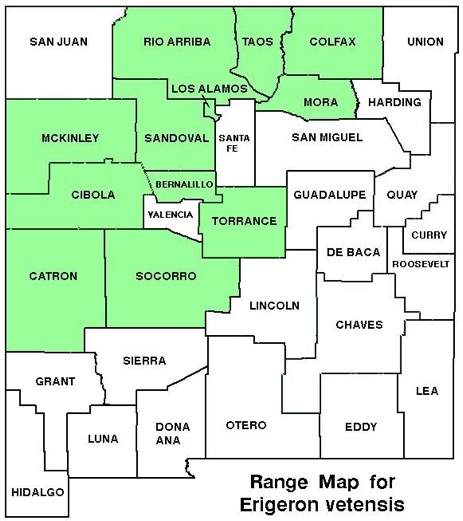WILDFLOWERS OF NEW MEXICO

Clumps have stems 2–10-inches tall and covered with scattered, stiff hairs and dense glandular hairs; flower heads, solitary on stem with bluish-white rays and a yellow disk, prefers rocky, exposed mountain ridges. Note the basal rosette or narrow, linear leaves with coarse hairs along the margins.
FLOWERS: April–June. Single flower heads have 30–90 white to bluish petal-like ray flowers, each 1/4–5/8-inch long (6–16 mm), around a yellow disk. The phyllaries beneath the rays are sparsely to moderately hairy with coarse, stiff hairs with or without glands.
LEAVES: Basal and alternate on stem. A dense basal rosette and 1–2 smaller stem leaves present at blooming. Basal leaves long, narrow, linear, 3/4–3 1/2-inches long (2–9 cm). Stem leaves reduced upward; surfaces sparsely hairy, margins entire with prominent stiff hairs.
HABITAT: Sandy, rocky soils, ridges, slopes, barren rocky outcrops; ponderosa-Douglas fir, spruce-fir forests.
ELEVATION: 7,600–11,600 feet.
RANGE: CO, NM, WY.
SIMILAR SPECIES: Spreading Fleabane, E. divergens, has 10–18-inch tall, branching stems with nodding buds.
NM COUNTIES: Northwest half of NM in mid- to high-elevation habitats: Bernalillo, Catron, Cibola, Colfax, Los Alamos, McKinley, Mora, Rio Arriba, Sandoval, Socorro, Taos, Torrance.

EARLY BLUE-TOP FLEABANE
ERIGERON VETENSIS
Aster Family, Asteraceae
Perennial herb



THE CONTENTS OF THIS WEBSITE ARE COPYRIGHTED AND CANNOT BE USED
WITHOUT PERMISSION OF GEORGE OXFORD MILLER




Rough hairs cover the leaf edges (left), and the stem and phyllaries (above).


E. vetensis commonly grows on rocky limestone outcrops on mountain ridges.
(photo Sandia Crest)
EMAIL ME